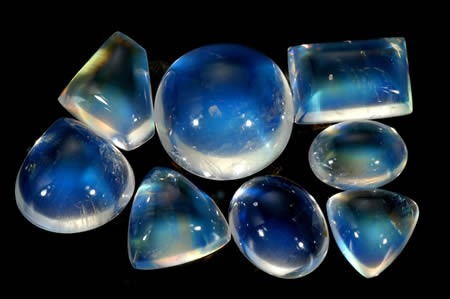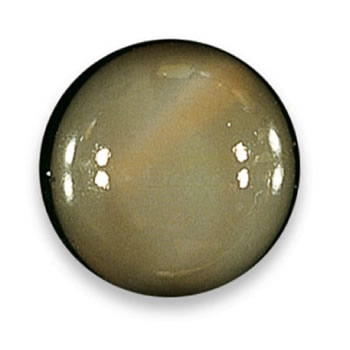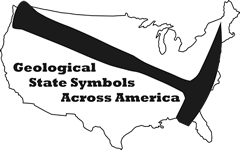Florida
Type |
Symbol |
Year Est. |
|---|---|---|
State Stone |
Agatized Coral |
1976 |
State Gem |
Moonstone |
1970 |
State Stone: Agatized Coral
Title IV
EXECUTIVE BRANCH
Chapter 15
SECRETARY OF STATE
15.0336 State stone.
Agatized coral, a chalcedony pseudomorph after coral, appearing as limestone geodes lined with botryoidal agate or quartz crystals and drusy quartz fingers, indigenous to Florida, is hereby designated the Florida state stone.
History.—s. 1, ch. 79-278.

An example of some brain coral, still alive (pre-fossilization). Image from UNC.edu.
Coral is an invertebrate animal that belongs to the group Cnidaria. Cnidaria also includes the well known jelly fish and sea anemones. Corals are a sessile organism, meaning that they live most of their life in one location, mainly rooted to the ocean floor. The coral animal, called a polyp, is a tiny organism that secrets a calcium carbonate "shell" around itself, like a clam. The accumulations of many of these shells is what most people think of when they think of coral. Neighboring polyps also secrete a shell and attached themselves to other polyp shells. This creates an apartment building type complex with tiny animals, each about the size of a nickel, living within each shell all attached to one another. Over time the animals die and new corals attach to the upper surfaces creating new structures. The coral animals themselves actually form a symbiosis with an algae called a zooxanthellae, where the algae creates the food from the sunshine and the corals eat the food. The corals then provide the algae with protection within their shell. Corals are generally found within fairly shallow and warm waters. These waters allow many corals to grow and the algae to create food. Over time the coral skeletons/shells can eventually build up and form a reef.

A piece of agatized coral from Florida. Image from Imagineyourflorida.com.
The agatization process is twofold. The first part is replacing the original skeleton of the coral, the calcium carbonate, with silica, typically known as the mineral quartz or chalcedony. This processes is referred to as "silicification". The second part is filling the hollow interiors of the coral with banded chalcedony, which is the actual agatization of the coral. Although living coral can be found in modern day Florida, the agatized coral would have to be much older to have gone through the agatization/fossilization process. The agatized coral are fossils that lived during the Oligocene to Miocene periods (38-25 million years ago). The corals originally formed on an ancient sea bed when most of Florida was under water as part of the continental shelf. The waters of the sea were rich in silica and other trace minerals, giving the agatized corals a large variety of colors including white, pink, grey, brown, black, yellow, and red. Within Florida, the agatized coral is most often found in the Tampa Bay area, the Withlacoochee/Suwannee River, and the Econfina River. Besides just a valued collectors item, the agatized coral was first used by the early inhabitants of Florida to make tools such as arrow heads and knives nearly 7,000 years ago.
Related: Hawaii State Gem - Black Coral; West Virginia State Gem - Fossil Coral
State Gem: Moonstone
Title IV
EXECUTIVE BRANCH
Chapter 15
SECRETARY OF STATE
15.034 State gem.
The moonstone, a transparent or translucent feldspar of pearly or opaline luster, is hereby designated the Florida state gem.
History.- s. 1, ch. 70-53.

Moonstones exhibiting the optical property of adularescence. Image from Geologyin.com
The term "moonstone" actually applies to the mineral orthoclase (formula KAlSi3O8) that exhibits certain optical properties. Othoclase is a mineral within the Felspar group, one of the largest groups of minerals, representing over 60% of the rocks in the Earth's crust. During formation of the Moonstone, as the mineral crystallizes the feldspar minerals orthoclase and albite (another feldspar mineral) separate into alternating layers. When the light falls between these layers it produces a scattering of the light called adularescence. In short, adularescence is specifically the metallic glow of a mineral that originates from below the surface, which is caused by light reflecting off the layers within a mineral.

A gem of Moonstone that resembles the moon. Image from myflorida.com.
The effect of the adularescence produces a schiller, or a milky bluish luster, that emanates from below the surface of the moonstone. One of the most remarkable properties of the Moonstone, is that the schiller appears to move as the gem is moved. This gives it the effect of lunar light floating on a surface of water, which gave the gemstone its name. Because of the visual effect of the gem, it was once thought to have been formed by the capturing of the moonbeams in Hindu mythology. The gemstone is also often associated with artistic creations, as well as the 1960's "flower child" apparel. The moonstones themselves can be found in colorless, white, grey, green, peach, and brown varieties. However, even though the moonstone is the State Gem of Florida, it is not found in Florida. It was chosen as the State Gem based on its name. In 1970, one year after first landing on the moon by the Apollo 11 crew, the Moonstone was chosen by lawmakers as the State Gem to honor this accomplishment, which launched from the Kennedy Space Center on Merritt Island, Florida.
References
https://statesymbolsusa.org/states/united-states/florida
https://www.icriforum.org/about-coral-reefs/what-are-corals
https://oceanservice.noaa.gov/facts/coral.html
https://college.unc.edu/2019/02/coral-marine-protected-areas/
https://www.stetson.edu/other/gillespie-museum/agatized-coral.php
https://imagineourflorida.org/agatized-coral/
https://www.gia.edu/moonstone-history-lore
https://www.orlandosentinel.com/news/os-xpm-2005-11-13-swnewcomer13-story.html
https://dos.myflorida.com/florida-facts/florida-state-symbols/state-gem/
http://www.leg.state.fl.us/statutes/index.cfm?App_mode=Display_Statute&URL=0000-0099/0015/0015.html
Geology of Florida's National Parks
Through Pictures
(at least the one's I have been to)
Visited in 2003
.jpg)
Back a long time ago during a Spring Break trip of 2003, my girlfriend (at the time) and I hit up the Canaveral National Seashore. And although the pictures taken at the time weren't geologically inclined, there is still geology that abounds. The seashore is made up of several geological features, mainly a barrier island beach and the sheltered lagoon, which provides an safe space for the wildlife in the region, properly termed an estuary.
.jpg)
The barrier island, as seen here with me attempting to enter the Atlantic Ocean, is a protective sand beach environment that breaks up the waves before they can hit the mainland. This beach, detached from the mainland, is created by the inward movement of the waves interacting with the outward movement of the waves, also known as the riptide. At this location where the waves interact, the ability of the water to carry sediment out to sea is reduced and the sand drops to the ocean floor. Over time this sand piles up, eventually becoming an island strip that acts as a barrier to the ocean waves and provides a safe and quiet lagoon between the island and the mainland. Canaveral National Seashore provides 24 miles of undeveloped beach, the longest continuous stretch in all of eastern Florida.
.jpg)
Although not directly geological, as a paleontologist I am also a biologist at heart and so the ecology, the fauna, and the flora of different parks also interests me. Here we have several instances of the fauna of the park with the first being an armadillo. We actually encountered quite a few of these guys, much more than I had ever seen before or since.
.jpg)
Checking out the beach at night allowed me to find some crabs scuttling along.
.jpg)
And some of my favorite wildlife, the manatees. The lagoon provides a perfect habitat for them, protecting them from the strong ocean waves and providing them with a reliable supply of food.
Visited in 2018
On a trip to visit my mother in Florida, I managed to convince the family to hit up the nearby national park.
.jpg)
The obligatory entrance sign with my Gummy Bear.
.jpg)
The park sits at the mouth of Tampa Bay along the south shore of the Manatee River. This is an estuary environment where the salt water from the Gulf of Mexico mixes with the fresh water from the Manatee River.
.jpg)
The ecological environments within this small park range from beach front dune to mangrove swamp.
.jpg)
But with many archeological parks, one of the primary geological aspects are the building stones used to make the dwellings. Here we have the remains of the "Tabby House". Tabby is a building stone made from the mixture of oyster shells, lime, sand, and water creating a hardened stone brick over about three days. The bricks were then coated in a plaster of lime, sand, and water.
.jpg)
A view over DeSoto Point overlooking the Manatee River.
.jpg)
Here is a shell midden, which is essentially a garbage pile of discarded remains of mollusks, shellfish, and bones. You can see within this midden the rather large gastropod (snail) shells.
.jpg)
Another geological aspect commen in many parks are the building stones used in monuments. Here is a view of the Holy Eucharist Monument. The base of the monument is limestone cut in Mankato, Minnesota. The limestone in use is the Ordovician age Kasota limestone, which is actually a dolomitic limestone, part of the Oneota dolomitic strata. The color of the stone is known as a "buff color" which is that slightly reddish-brown color due to the 1% iron oxide composition providing a rust staining to the stone. Although the Kasota does not have many fossils, it does have a significant number of traces fossils running through the rock, however I am not certain the type of trace fossils preserved.
The carving stone came from Madrid, unfortunately I cannot find any information about the type of stone used, nor did I take any better pictures or get a closer look at the stone to determine for myself.
.jpg)
Taking a stroll though the dense beach forest.
.jpg)
The Desoto Trail marker, using "granite" from an unknown location.
.jpg)
A closer view of the "granite", but based on this picture it may more accurately be described as a diorite, however I don't recall what type of rock it was from my visit.
References


